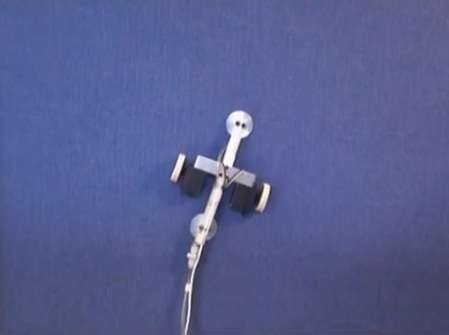In this clip from the video below, the robot crawls up a wall using a non-contact vacuum grip, due to Bernoulli's principle. Image credit: University of Canterbury.
(PhysOrg.com) -- Instead of using sticky footpads to climb on walls and ceilings, a new robot takes advantage of fast-moving air that can generate an adhesion force on just about any kind of surface. The robot’s grippers, which don’t ever actually touch the surface as the robot climbs, operate on Bernoulli’s principle of fluid dynamics.
The robot was developed by researchers at the University of Canterbury in New Zealand, with the results published in a recent ICRA paper by Matthew Journee, et al.
According to Bernoulli’s principle, when a fluid (such as air) moves faster, its pressure decreases. To generate extremely fast-moving air, the researchers designed round grippers with tiny 25-μm gaps around the rim, out of which high-speed air can be forced. This design can compress the airflow so much that the air reaches supersonic speeds of Mach 3. The fast-moving air creates a low-pressure vortex inside the grippers that’s strong enough to pull the robot toward nearby surfaces, such as walls and ceilings, without actually touching them. The robot can roll on its two wheels, but the grippers are separated from the surface by a small gap.
The robot demonstrates adhesion with supersonic air jets on a variety of surfaces. Video credit: University of Canterbury.
Non-contact Bernoulli grippers have previously been used to pick up lightweight objects, especially those that are sterile or fragile. But in order to use the principle to enable a robot to climb, the researchers had to make the grippers five times stronger than the conventional version. They achieved this increase in strength by the carefully designed gaps, without the need for additional air pressure.
The non-contact grippers could have applications in industrial inspections, and should be available in the coming months.
More information: IEEE Spectrum
© 2010 PhysOrg.com























